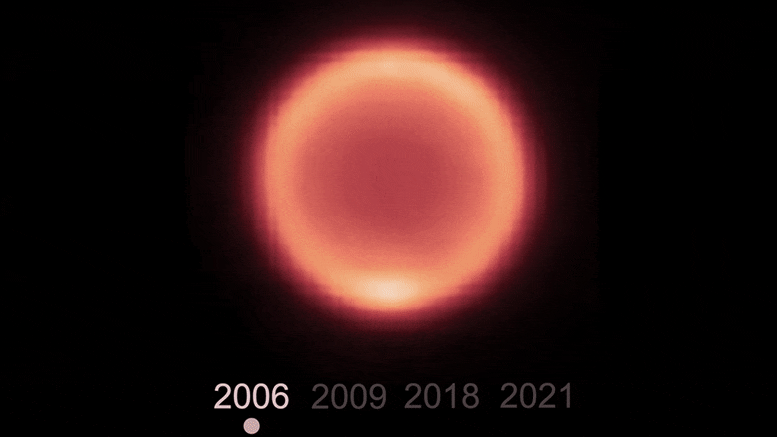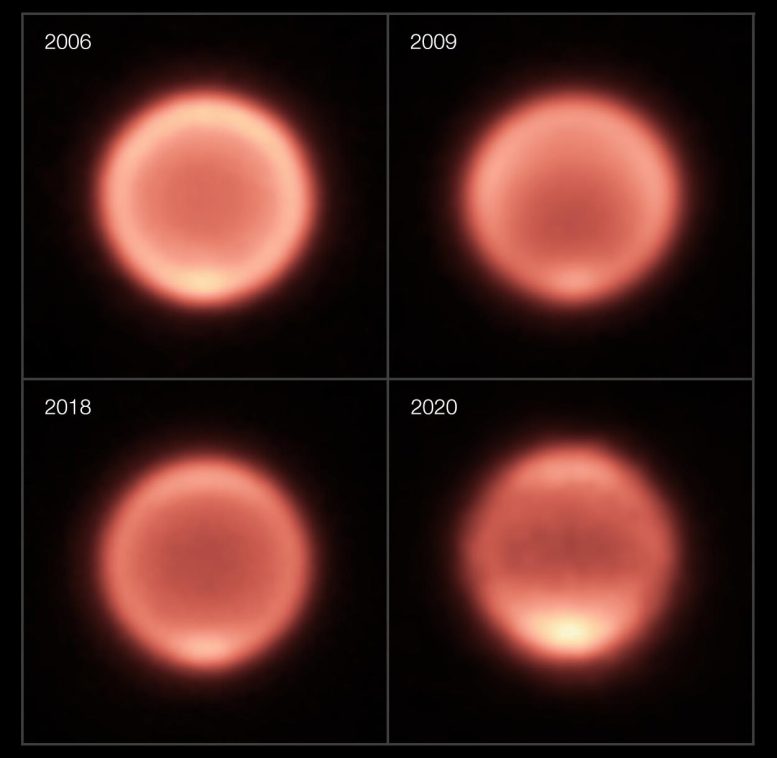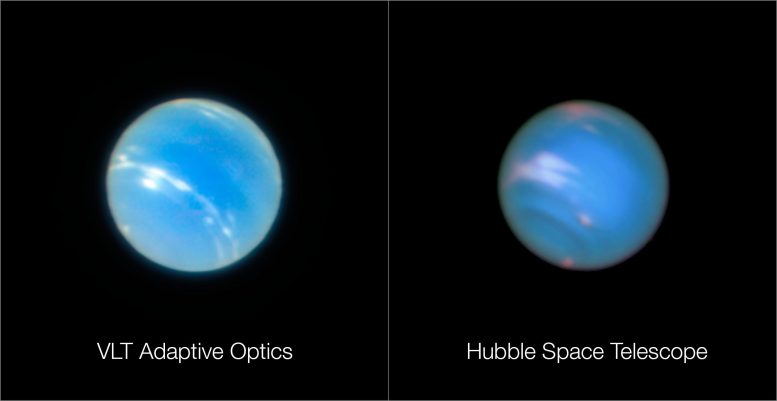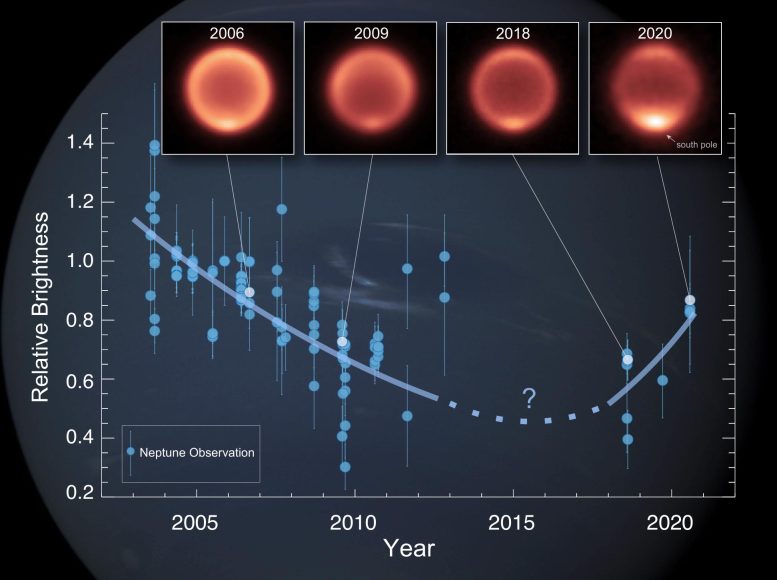
Posted on 02/17/2024 5:03:03 PM PST by Red Badger

Over a 17-year period, an international team of astronomers monitored Neptune’s atmospheric temperatures. They discovered that Neptune’s global temperatures dropped unexpectedly, followed by a dramatic warming at its south pole. Credit: ESO/M. Roman
~~~~~~~~~~~~~~~~~~~~~~~~~~~~~~~~~~~~~~~~~~~~~~~~~~~~~~~~~~
Using ground-based telescopes, including the European Southern Observatory’s Very Large Telescope (ESO’s VLT), an international team of astronomers track Neptune’s atmospheric temperatures over a 17-year period. They found a surprising drop in Neptune’s global temperatures followed by a dramatic warming at its south pole.
“This change was unexpected,” says Michael Roman, a postdoctoral research associate at the University of Leicester, UK, and lead author of the study published on April 11, 2022, in The Planetary Science Journal. “Since we have been observing Neptune during its early southern summer, we expected temperatures to be slowly growing warmer, not colder.”
Like Earth, Neptune experiences seasons as it orbits the Sun. However, a Neptune season lasts around 40 years, with one Neptune year lasting 165 Earth years. It has been summertime in Neptune’s southern hemisphere since 2005, and the astronomers were eager to see how temperatures were changing following the southern summer solstice.

This composite shows thermal images of Neptune taken between 2006 and 2020. The first three images (2006, 2009, 2018) were taken with the VISIR instrument on ESO’s Very Large Telescope while the 2020 image was captured by the COMICS instrument on the Subaru Telescope (VISIR wasn’t in operation in mid-late 2020 because of the pandemic). After the planet’s gradual cooling, the south pole appears to have become dramatically warmer in the past few years, as shown by a bright spot at the bottom of Neptune in the images from 2018 and 2020. Credit: ESO/M. Roman, NAOJ/Subaru/COMICS
~~~~~~~~~~~~~~~~~~~~~~~~~~~~~~~~~~~~~~~~~~~~~~~~~~~~~~~~~~~~~~~~~~~~~~~~
Astronomers looked at nearly 100 thermal-infrared images of Neptune, captured over a 17-year period, to piece together overall trends in the planet’s temperature in greater detail than ever before.
These data showed that, despite the onset of southern summer, most of the planet had gradually cooled over the last two decades. The globally averaged temperature of Neptune dropped by 8 °C (14 °F) between 2003 and 2018.
The astronomers were then surprised to discover a dramatic warming of Neptune’s south pole during the last two years of their observations, when temperatures rapidly rose 11 °C (20 °F) between 2018 and 2020. Although Neptune’s warm polar vortex has been known for many years, such rapid polar warming has never been previously observed on the planet.

The image of the planet Neptune on the left was obtained during the testing of the Narrow-Field adaptive optics mode of the MUSE instrument on ESO’s Very Large Telescope. The image on the right is a comparable image from the NASA/ESA Hubble Space Telescope. Note that the two images were not taken at the same time so do not show identical surface features. Credit: ESO/P. Weilbacher (AIP)/NASA, ESA, and M.H. Wong and J. Tollefson (UC Berkeley)
~~~~~~~~~~~~~~~~~~~~~~~~~~~~~~~~~~~~~~~~~~~~~~~~~~~~~~~~~~~~~~~~~~~~~~~~
“Our data cover less than half of a Neptune season, so no one was expecting to see large and rapid changes,” says co-author Glenn Orton, senior research scientist at Caltech’s Jet Propulsion Laboratory (JPL) in the US.
The astronomers measured Neptune’s temperature using thermal cameras that work by measuring the infrared light emitted from astronomical objects. For their analysis, the team combined all existing images of Neptune gathered over the last two decades by ground-based telescopes. They investigated infrared light emitted from a layer of Neptune’s atmosphere called the stratosphere. This allowed the team to build up a picture of Neptune’s temperature and its variations during part of its southern summer.

Observed changes in Neptune’s thermal-infrared brightness, a measure of temperature in Neptune’s atmosphere. The plot shows the relative change in the thermal-infrared brightness from Neptune’s stratosphere with time for all existing images taken by ground-based telescopes. Brighter images are interpreted as warmer. Corresponding thermal-infrared images (top) at wavelengths of ~12 µm show Neptune’s appearance in 2006, 2009, 2018 (observed by the European Southern Observatory’s Very Large Telescope’s VISIR instrument), and 2020 (observed by Subaru’s COMICS instrument). The south pole appears to have become dramatically warmer in just the past few years. Credit: Michael Roman/NASA/JPL/Voyager-ISS/Justin Cowart
~~~~~~~~~~~~~~~~~~~~~~~~~~~~~~~~~~~~~~~~~~~~~~~~~~~~~~~~~~~~~~~~~~~
Because Neptune is roughly 4.5 billion kilometers away and is very cold, the planet’s average temperature reaches around –220 °C (–364 °F), measuring its temperature from Earth is no easy task. “This type of study is only possible with sensitive infrared images from large telescopes like the VLT that can observe Neptune clearly, and these have only been available for the past 20 years or so,” says co-author Leigh Fletcher, a professor at the University of Leicester.
Around one-third of all the images taken came from the VLT Imager and Spectrometer for mid-InfraRed (VISIR) instrument on ESO’s VLT in Chile’s Atacama Desert. Because of the telescope’s mirror size and altitude, it has a very high resolution and data quality, offering the clearest images of Neptune. The team also used data from NASA’s Spitzer Space Telescope and images taken with the Gemini South telescope in Chile, as well as with the Subaru Telescope, the Keck Telescope, and the Gemini North telescope, all in Hawai‘i.
VIDEO AT LINK.......................
The evolution of thermal images taken from Neptune using the VLT’s VISIR instrument. The images, taken between 2006 and 2021, show Neptune gradually cooling down, before a dramatic heating of its south pole in the last few years. Credit: ESO/M. Roman
Because Neptune’s temperature variations were so unexpected, the astronomers do not know yet what could have caused them. They could be due to changes in Neptune’s stratospheric chemistry, or random weather patterns, or even the solar cycle. More observations will be needed over the coming years to explore the reasons for these fluctuations. Future ground-based telescopes like ESO’s Extremely Large Telescope (ELT) could observe temperature changes like these in greater detail, while the NASA/ESA/CSA James Webb Space Telescope will provide unprecedented new maps of the chemistry and temperature in Neptune’s atmosphere.
“I think Neptune is itself very intriguing to many of us because we still know so little about it,” says Roman. “This all points towards a more complicated picture of Neptune’s atmosphere and how it changes with time.”
For more on this discovery, see Unexpected Atmospheric Temperature Changes Detected on Neptune.
Reference:
“Sub-Seasonal Variation in Neptune’s Mid-Infrared Emission” by Michael T. Roman, Leigh N. Fletcher, Glenn S. Orton, Thomas K. Greathouse, Julianne I. Moses, Naomi Rowe-Gurney, Patrick G. J. Irwin, Arrate Antuñano, James Sinclair, Yasumasa Kasaba, Takuya Fujiyoshi, Imke de Pater and Heidi B. Hammel, 11 April 2022, Planetary Science Journal.
DOI: 10.3847/PSJ/ac5aa4
The team is composed of M. T. Roman and L. N. Fletcher (School of Physics and Astronomy, University of Leicester, UK), G. S. Orton (Jet Propulsion Laboratory/California Institute of Technology, California, USA), T. K. Greathouse (Southwest Research Institute, San Antonio, TX, USA), J. I. Moses (Space Science Institute, Boulder, CO, USA), N. Rowe-Gurney (Department of Physics and Astronomy, Howard University, Washington DC, USA; Astrochemistry Laboratory, NASA/GSFC, Greenbelt, MD, USA; Center for Research and Exploration in Space Science and Technology, NASA/GSFC, Greenbelt, MD, USA), P. G. J. Irwin (University of Oxford Atmospheric, Oceanic, and Planetary Physics, Department of Physics Clarendon Laboratory, Oxford, UK), A. Antuñano (UPV/EHU, Escuela Ingernieria de Bilbao, Spain), J. Sinclair (Jet Propulsion Laboratory/California Institute of Technology, California, USA), Y. Kasaba (Planetary Plasma and Atmospheric Research Center, Graduate School of Science, Tohoku University, Japan), T. Fujiyoshi (Subaru Telescope, National Astronomical Observatory of Japan, HI, USA), I. de Pater (Department of Astronomy, University of California at Berkeley, CA, USA), and H. B. Hammel (Association of Universities for Research in Astronomy, Washington DC, USA).
More proof that we must end "fossil" fuels.
Neptune’s temperature drop is due to switching to EV’s from gasoline engines. /S
Those evil white males with pocket protectors and slide rules made the Voyager Spacecraft fly by Neptune. Launched in the 1970s, they successfully calculated what was called the Grand Tour: Saturn, Jupiter, Neptune and, of course, Uranus.
The Woke Wackos of Climate Change will probably blame the Neptunian Climate Change on those evil Caucasians with pocket protectors. They’ll say Voyager was permanently tinged with white privilege and white supremacy. They will demand that Elon Musk make amends for ruining Twitter by sending Starship to retrieve and re-educate Voyager, to get Voyager’s mind right.
(Voyager has, or will soon, leave the entire Solar System. Look up heliosphere to learn more about really ‘leaving’ the Solar System, and entering interstellar space.)
Sort of suspected something like that as my old bones seemed to be getting harder to keep warm, for the past few years...
Guess its time to move to the south pole...
Is Uranus also getting hot or cold?
That’s so magnanimous of you. 🤣
We obviously need to send a bunch of federal bureaucrats to Neptune immediately. In fact, let’s send them all there.
Elon, quick, help us out here. We need the super-gigantic Starship. Probably a whole fleet of them. No return is necessary.
(1) Neptune, Earth and other large planets have accumulations at their core of uranium that cause ongoing nuclear reactions that produce heat. These reactions are variable due to periodic poisoning and then clearance by decay of adverse isotopes.
(2) Magnetic and gravitational influences from the solar system input energy into Neptune, which varies according to its polar inclination and its angle to the plane of the ecliptic. (3) There are clumps of dark matter that are associated with the solar system that react with visible matter and can input energy on variable basis.
Just Stop Earl
So - parts warmed up and others cooled down - with, likely, a net sum zero change in planetary temperature - just like on Earth....
Disclaimer: Opinions posted on Free Republic are those of the individual posters and do not necessarily represent the opinion of Free Republic or its management. All materials posted herein are protected by copyright law and the exemption for fair use of copyrighted works.